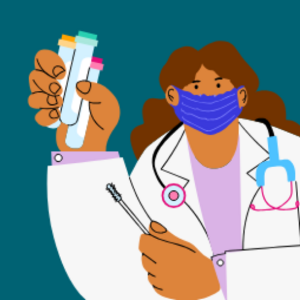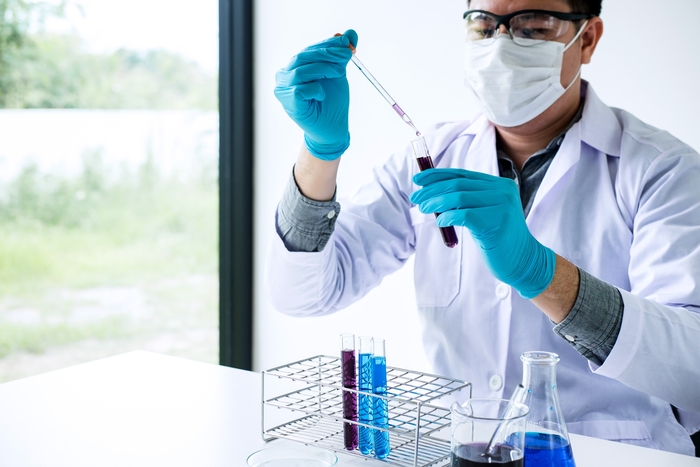
Ensure your health. Get tested today.
Convenient lab testing at your fingertips at more than 5,000 locations nationally. Consult with a doctor, or get tested on your own.

A hair follicle drug test can detect whether a person has illicit or prescription drugs in their system. If you’re about to have a hair drug test or want a loved one to take this test, it may help to know how long drugs stay in hair follicles, how effective the tests are, and where you can get a test from a quality provider in your area.
A hair drug test is a type of drug test that uses several of your hair follicles to test for the presence of drugs in your body. During this test, a lab technician cuts a small number of hairs from your head using a pair of scissors. Your hair sample is then sent to a lab where technicians screen it for the presence of drug use within the last 90 days according to the National Institutes of Health (NIH).
A common misconception of a hair drug test is that the test requires a sample of the actual hair follicle. This would require the hair to be pulled from the scalp by its root. However, this is normally only required for genetic and DNA testing, according to NIH.
According to the NIH, a hair drug test can detect the presence of:
Marijuana
Cocaine
Opioids
Amphetamines
Methamphetamine
PCP
Ecstasy
Some people think they can avoid testing positive for drugs with a hair test if they shave all the hair from their head. However, hair samples can be taken from nearly anywhere on the body, and not just on the head. Those who shave all their body hairs in an attempt to escape a positive result may face consequences such as being denied employment, according to MedlinePlus.
According to the Society for Human Resource Management, hair drug tests are used by approximately 7% of employers that screen employees for drug use. This type of drug test may be used by employers, courts, addiction treatment centers, and individuals who want themselves or a loved one tested for drug use, reports the NIH.

Convenient lab testing at your fingertips at more than 5,000 locations nationally. Consult with a doctor, or get tested on your own.
During a hair drug test, a small sample of hair is collected from the individual, typically from the scalp, although body hair may also be used if necessary, according to MedlinePlus. The collector will cut a small section of hair close to the scalp, usually around 1.5 inches in length, as this length can provide a history of drug use over the past 90 days. The collected hair sample is then sent to a laboratory, where it undergoes a thorough analysis to detect the presence of various drugs and their metabolites.
The lab uses techniques such as enzyme-linked immunosorbent assay (ELISA) and gas chromatography-mass spectrometry (GC-MS) to identify and quantify any substances found in the hair. Results are typically reported back to the requesting party, indicating whether drugs were detected and, if so, at what levels.
Hair takes time to grow, and hair drug tests may not show whether a person has used drugs during the past few days. Many times, it can take between five and seven days for substances to be detectable on a hair follicle drug test. According to MedlinePlus, a hair test can only show whether a person has used certain drugs within the last 90 days. It cannot reveal the frequency of drug use.
Additionally, according to the University of Richmond, hair follicle tests may come back positive for people who may have been exposed to certain drugs without actually using them. For example, cocaine can bind to a substance in hair called melanin, which controls the pigment of your hair. If you had entered a room where people were snorting cocaine, it’s possible some cocaine may have landed in your hair and caused you to test positive for it.
Lastly, hair follicle tests cannot reveal how often you do drugs. If you were using marijuana nearly three months ago and stopped because you decided to seek treatment at a drug rehab center, that drug will still show up in your system despite not using it for almost 90 days, according to a study in Drug and Alcohol Dependence . This can be problematic for those who have decided to become healthy. Some people cannot secure employment due to previous drug use and a positive hair test for marijuana.
A hair follicle test can detect whether you have used certain types of drugs at any point during the last 90 days, according to a study in Drug and Alcohol Dependence. However, this drug test does not reveal how often you used those drugs during that time frame.
Hair follicle testing follows a specific set of standards that help protect its accuracy and prevent false-positive results, according to MedlinePlus. The results of a hair follicle drug test provide insights into an individual's drug use history by analyzing substances present in the hair. Understanding how to read hair follicle test results levels is crucial, as different levels indicate varying degrees of substance use. For those concerned about the outcome, researching how to pass a hair follicle test can offer strategies to mitigate the effects of past drug use and improve the chances of a favorable result.
Negative results from a hair follicle drug test indicate that no drugs were detected in the hair sample, suggesting that the individual has not used the substances tested for within the detection window, typically the past 90 days. MedlinePlus notes that this outcome is often viewed favorably in employment and legal contexts, as it demonstrates compliance with drug-free policies. However, it's important to note that negative results do not necessarily guarantee that the individual has never used drugs; rather, it reflects the absence of detectable levels at the time of testing.
Positive results from a hair follicle drug test show that one or more drugs were detected in the hair sample, indicating recent use within the detection window, according to MedlinePlus. The report will typically specify the substances identified and their corresponding levels. A positive result can have significant implications, including potential disciplinary action in the workplace, legal consequences, or the need for further evaluation and treatment. It is crucial for individuals receiving a positive result to understand their options, including the possibility of retesting or providing context for their drug use history.
In previous years, foods like poppy seeds and hemp seeds often produced false-positive results, but today, labs conduct two separate tests to guard against false positives. According to data from MedlinePlus, the first test, called the ELISA test, produces a negative or positive result within 24 hours. The second test, called the GC/MS test, has the ability to confirm whether a positive result is truly positive, as it guards against substances that may cause false positives.
The only time a hair follicle test will produce a false positive is when you are using a prescription medication that can be detected by the hair test, such as an opioid medication, according to MedlinePlus. If this occurs, you may be asked to provide proof of a valid prescription for that particular substance.
According to data from MedlinePlus, hair follicle drug tests can cost anywhere between $15 and $125, depending on factors including the test manufacturer, fees set by the testing provider, and your geographical location. The cost may be covered by your employer if it is required for employment. In other cases, your health insurance provider may pay for it if your doctor deems this test medically necessary based on your health situation.
Hair drug tests and urine drug tests each come with their own set of pros and cons. One of the primary benefits of a hair drug test is its relatively long detection window. A hair test can determine whether a person has used drugs within the last 90 days, while a urine test can only detect drug use during the last three days, based on data published in Drug and Alcohol Dependence .
Though a hair drug test may be better at determining whether a person has used drugs in the last 90 days, it doesn’t necessarily reveal the frequency of drug use. These tests also tend to be higher in cost than urine tests. According to Drug and Alcohol Dependence , some people are resistant to submit to hair drug testing due to concerns it may affect their physical appearance after a large number of hairs are removed for the test.
A urine test is usually less invasive than a hair test, as it catches a small sample of urine that needs to be expelled from the body regardless of testing. In comparison, a hair test leads to a small amount of hair loss, as it involves cutting a sample of hairs from your scalp.
Choosing between a hair follicle test and a urine drug test or mouth swab test comes down to a matter of personal preference, or to that of the employer, court, or organization requiring the drug test.
The easiest way to find a hair drug test provider near you is to visit Solv. Solv can provide you with a list of highly-rated lab testing providers in your area, as well as the opportunity to book a same-day appointment at a walk-in clinic . Visit Solv today to benefit from convenient, hassle-free healthcare for you and your entire family.
A hair follicle test can detect marijuana, cocaine, opioids, amphetamines, methamphetamine, PCP, and ecstasy.
A hair follicle test can detect drug use within the last 90 days.
No, a hair follicle test cannot reveal the frequency of drug use.
Yes, hair follicle tests may produce false positives due to environmental exposure to certain drugs.
The cost of a hair follicle test can range from $15 to $125, depending on the test manufacturer, fees set by the testing provider, and your geographical location.
The easiest way to find a hair drug test provider near you is to visit Solv. Solv can provide you with a list of highly-rated lab testing providers in your area, as well as the opportunity to book a same-day appointment at a walk-in clinic. Visit Solv today to benefit from convenient, hassle-free healthcare for you and your entire family.